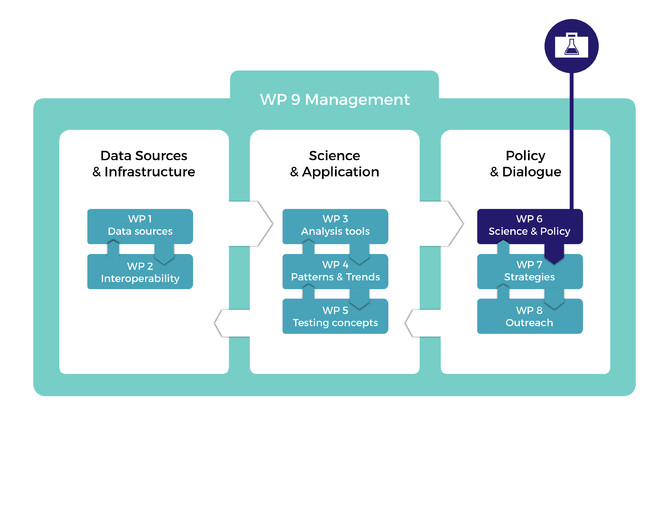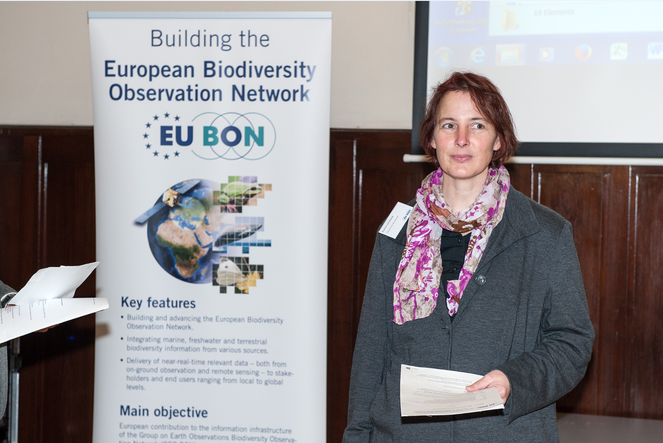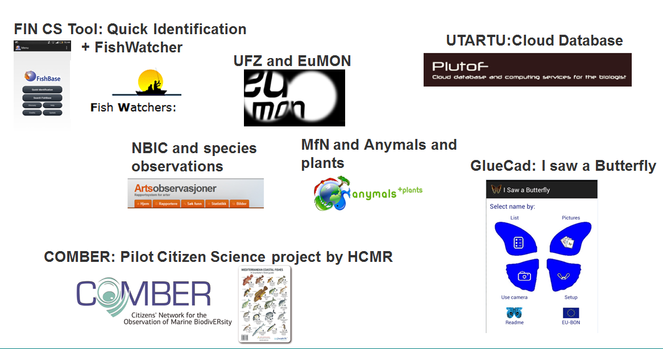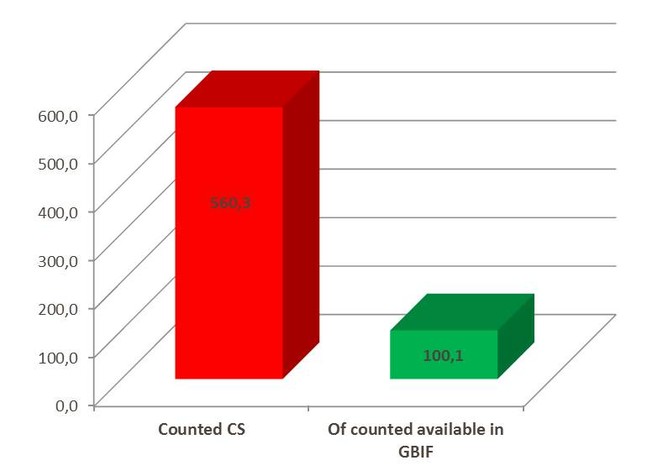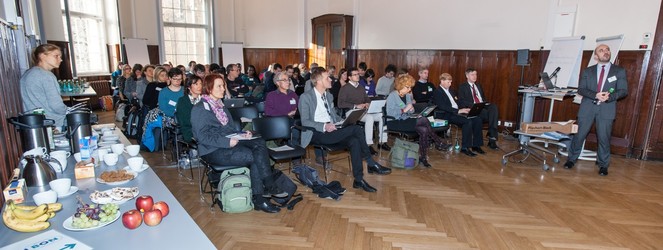|
Research Ideas and Outcomes : Project Report
|
|
Corresponding author: Florian T. Wetzel (florian.wetzel@mfn-berlin.de)
Received: 24 Mar 2016 | Published: 24 Mar 2016
© 2016 Katrin Vohland, Christoph L. Häuser, Eugenie Regan, Anke Hoffmann, Florian T. Wetzel.
This is an open access article distributed under the terms of the Creative Commons Attribution License (CC BY 4.0), which permits unrestricted use, distribution, and reproduction in any medium, provided the original author and source are credited.
Citation: Vohland K, Häuser C, Regan E, Hoffmann A, Wetzel F (2016) 2nd EU BON Stakeholder Roundtable (Berlin, Germany): How can a European biodiversity network support citizen science? Research Ideas and Outcomes 2: e8616. doi: 10.3897/rio.2.e8616
|

|
Abstract
The second EU BON Stakeholder Roundtable took place on 27 November 2014 at the Museum für Naturkunde in Berlin. The roundtable was dedicated to explore ways in which EU BON can support citizen science (CS) activities. EU BON is building an integrated biodiversity information platform in order to serve science, policy and administration. Also citizen scientists and related projects and networks are important stakeholders. Moreover, citizen scientists can play an essential role for biodiversity networks, as they support the increase of knowledge in the field of biodiversity in various aspects: they may debate research questions, most often they collect data in the field, and they may interpret data and publish their results.
At the stakeholder roundtable in Berlin, various stakeholders from the field of citizen science were invited to discuss possibilities of interactions and the role of EU BON for supporting citizen science on a European scale. EU BON products could help CS stakeholders in various ways, e.g. with tools for the standardization of data and training on widely used and accepted data collection standards, as well as tools for the visualization/interpretation of data. Also best-practice examples and guidelines could help for developing a sound projects design as well as for data curation, storage and reward mechanisms for the community (e.g. by making data citable, publication of data papers etc.).
The discussions and break-out groups gave valuable impulses for the development of the EU BON portal and citizen science gateway, for data mobilization from different communities, and the linkage to the European Citizen Science Association (ECSA) and its activities. The main outcomes and results of the workshop are outlined and summarized in this roundtable report.
Keywords
Citizen Science, biodiversity data, data quality, Biodiversity Observation Networks, EU BON, research data, European Citizen Science Association, Citizen Science Observatories.
Rationale
In this compilation of the EU BON Stakeholder Roundtable (RT) reports we want to provide a summarized overview, providing shared experiences gained in three different workshops that were organized by the EU BON project from 2013-2015, with altogether more than 100 participants from over 20 countries (ranging from Norway to Israel, and from the United States to Estonia).
Here we summarize the results of the second Stakeholder Roundtable - in addition to this report, also the summaries of the first (
EU BON - Building the European Biodiversity Observation Network (www.eubon.eu) is a project funded under the EU FP7 framework. It presents an innovative approach towards the integration of biodiversity data and information systems, both from in-situ and remote sensing data sources (Hoffmann et al. 2014). The aim is to address policy and information needs in a timely manner, customized for various stakeholders on different levels - from local test sites to European and international policy EU BON aims to provide integrated data and linkages of social science and policy networks as well as technological infrastructures (
The RT aimed to exchange ideas and discuss highly relevant issues with relevant stakeholders, from policy, citizen science and local/regional stakeholders in order to inform EU BON and adapt the working programme. Topics of the discussions were related to biodiversity information and its open-access and availability, data workflows and integration of citizen science as well as science-policy interfaces. We will start with a brief general overview of the project, particularly describing the overall framework and role of the stakeholder engagement in the policy and dialogue work package. Secondly, we provide detailed reports of each of the roundtables, outlining its aims, intentions, discussions as well as results and recommendations that were drafted based on the roundtable discussions, world café sessions and working groups which are now published for the first time in the new series of new series of EU BON Project Outcomes.
The Stakeholder Roundtables are a specific task and part of a Work Package (WP6, see
EU BON Work Packages (WP) with the three sections (a) Data Sources and Infrastructure, (b) Science and Application and (c) Policy and Dialogue. The Stakeholder Roundtables are a specific task in the WP 6 that targets the stakeholder engagement and science-policy dialogue (credits: Pensoft).
More specifically, the aims of the RT are defined in the description of work as follows: “This task will help to build and ensure regular and efficient linkages to relevant political authorities and other stakeholders at national and European level to support the development and delivery of the EU BON project. While stakeholder interactions will occur throughout EU BON, this task has two elements: the first is a support service for EU BON - mapping stakeholder engagement and providing contacts and support for stakeholder engagement to all relevant EU BON tasks. This will include establishing an overarching policy stakeholder group with contact points to relevant national and European level agencies and authorities involved in biodiversity and environmental policy, and GEO related activities. The second element will be a more focused series of three strategic stakeholder engagement processes that will occur at the beginning, middle and end of EU BON. Each interaction will take the form of an interactive workshop – at which high level stakeholders and scientists will work collaboratively to address three sets of questions: a) What major changes need to occur in order that current and future policy needs for biodiversity data are met? b) How effective are the current approaches for improving the availability and policy relevance of biodiversity data? c) What data strategies should be put in place to realise the lessons generated during EU BON?”
To address different stakeholders groups, the aims, guiding questions and invited groups were specifically adjusted in each of the workshops, resulting in three roundtables:
- “Biodiversity and Requirements for Policy” - 1st EU BON Stakeholder Roundtable (Brussels, Belgium). Addressed stakeholders: European policy (Commission, agencies, researchers), International Networks (Group on Earth Observations), EU funded projects with linkage to biodiversity data.
- “How can EU BON support citizen science?” - 2nd EU BON Stakeholder Roundtable (Berlin, Germany). Addressed stakeholders: Citizen Science projects, citizen science networks, researchers and biodiversity networks.
- “Workflow from data mobilization to practice” - 3rd EU BON Stakeholder Roundtable (Granada, Spain). Addressed stakeholders: European, national and regional networks (biodiversity data, Group on Earth Observations, ecological research), researchers from the field / sites, EU BON test site partners, political administration.
Introduction
EU BON is building a large integrated biodiversity information infrastructure in order to serve science, policy and administration as well as citizen scientists. Citizen scientists support the increase of knowledge in various aspects, they may debate research questions, most often they collect data, they may interpret data and publish their results.
The aim of the second EU BON Stakeholder Roundtable on Citizen Science (CS) was to explore how and with which means EU BON can support citizen science activities. Many partners and interested stakeholders participated in the stakeholder roundtable, coming from different European research institutions, Natural History Museums, SMEs or representatives from European Institutions like European Commission DG Research & Innovation, the European Environmental Agency or the JRC and EU-funded Citizen Science projects (see
Aims of the roundtable
The aim of the roundtable on Citizen Science was to explore how and with which means EU BON can support citizen science activities. EU BON may serve citizen scientists in many aspects, and here the citizen science community and biodiversity data community was given a forum to exchange ideas and develop perspectives. The roundtable was intended to bring together data providers as well as the user community and opened the discussion on the future of workflows. An introductory talk was held by Jose-Miguel Rubio-Iglesias from the European Commission on the role of Citizen Science as one option to improve the science-society bridge. Further contributions from data providers, portal developers, and innovative thinkers helped to discuss challenges with regards to citizen science and the role of a European Biodiversity Observation Network. In addition, the stakeholder roundtable intensifies the dialogue with policy. It will be discussed how legal and political conditions for citizen science activities can be improved. Outcome of the stakeholder roundtable are recommendations for EU BON in order to improve activities to empower citizen science initiatives (see chapter on the internal EU BON follow-up).
Key outcomes and discussions
Setting the scene
The second EU BON Stakeholder Roundtable started with the session “Setting the scene” with a welcome address by Katrin Vohland from the Museum für Naturkunde in Berlin with a short introduction and outline of the main aims of the workshop, which were to discuss the possible contribution of EU BON to support Citizen Science approaches related to biodiversity research (
As representative from DG Research and Innovation (European Commission), Jose-Miguel Rubio-Iglesias showed the possibilities of Citizen Science as one option to improve the science-society bridge. The collaborative power of information and communication technology (ICT) networks can help to create a collective intelligence that influences environmental policy making for individual and collective decision-making processes. These activities may also raise awareness about environmental issues and could lead to more sustainable individual and collective behaviours and lifestyles. However, also traditional communication forms are important and still many challenges exist for citizen science approaches. So-called Citizens Observatories are an important citizen science approach to complete environmental observation systems and can improve the local decision making. Five projects were funded under FP-7 that are covering that aspect.
Christoph Häuser (MfN) explained in his talk the aims and structure of EU BON. He referred to the ongoing global challenges to biodiversity and the need for a sound biodiversity information network. EU BON works on two networking levels: 1) a science based social network, 2) technological network of infrastructures and systems. The aim is to explore the potential of CS based approaches of EU BON partners, such examples are the mobile phone application 'Anymals and Plants' and other CS projects of EU BON partners (
Session: How can EU BON possibly support data mobilization of and for citizen scientists
The next session targeted the question of how EU BON can possibly support data mobilization of and for citizen scientists. Antonio García Camacho from CSIC Donana showed with a colleague from IBM the prototype of the future EU BON biodiversity portal, that aims to integrate biodiversity data/metadata sources into a single user interface. As a test case, data from GBIF is now searchable and can be identified with a single identifier. More data providers and their data will be integrated in the search interface in the future. Additionally, there should be not only biodiversity data integrated but different data. As a further feature, a taxonomic backbone for the European data is implemented (EU Nomen) so that species or other taxonomic groups can be searched by their names. In another talk, Jaume Piera (ICM Barcelona) pointed out the requirements that exist in a Citizen Science portal, e.g. the role of citizen collaboration, the social media channels, and particularly the conceptual requirements. Important aspects here are for example that data access tracking has to be guaranteed, for giving credits to data producers and not only to the persons who analyse the data and for keeping track of data use. Digital object identifiers can be used to do this tracking and the best way is to cite datasets and not data producers/individuals, as sometime hundreds of individuals provided data. Additionally reproducible queries for research are possible with and creation of data citation statistics. Simao Belchior of the SME Simbiotica showed ways of visualizing georeferenced data, e.g. pan-tropical forest clearing. The mapping of data has a strong stakeholder specific component that has to be included in the design of the approach. As it was articulated in the discussion, for citizen science also a strong involvement of the citizens is needed so that not only top-down approaches are created.
Session: A spotlight on some (meta)data provider
The session after the lunch break was called “A spotlight on some (meta)data provider“ and Veljo Runnel (UTARTU) started the session by presenting an assessment of Citizen Science involvement in biological research. Many researchers that participated in the survey are already involved citizen scientists (nearly two third, many are working e.g. on environmental protection and for NGOs, less e.g. in molecular biology), and most would use volunteer help in the future. Most respondents rated the quality of the data provided by volunteers with ‘satisfactory’ (78%). Furthermore, products of the EU BON citizen science task were presented. This included tools to collect data (mobile app), design data collection forms and publish them through a data curation infrastructure (PlutoF) and the EU BON helpdesk with a directory to existing platforms and tools. An overview of Christos Arvanitidis (HCMR) showed crowdsourcing initiatives in the Mediterranean basin (CIGESMED, AmvrakikosBirds and COMBER) and the Open Source technologies they use. It was pointed out that a proper coordination of the crowdsourcing activity at global scale is a must, and that, on a European level, the ESFRI Infrastructure is important as an incubation chamber for these initiatives.
Nils Valland (NBIC) described in his talk the key success factors for citizen science and species occurrence data in Europe. It is estimated that there are around 560 Mio. records of species occurrence data from CS sources, where around 100 Mio. are available via GBIF (
Species occurrence data records (in millions, x-axis) from CS sources, counted and freely available in Europe (Nils Valland, NBIC, updated in March 2016).
Key success factors can be grouped into the following success factors (
Dirk Schmeller (UFZ) informed the audience about Volunteer Species Monitoring in Europe. He pointed out the need that governments should invest more to support and expand current monitoring initiatives. For example the EuMon project had documented 395 monitoring schemes for species, which represents a total annual cost of about €4 million, involving more than 46,000 persons devoting over 148,000 person-days/year to biodiversity monitoring activities. Volunteer-based monitoring also reduces effective costs by the factor 8-10. In general, volunteer species monitoring offers several advantages (e.g. high sampling effort, large spatial coverage, faster turn-around time), however, also some caveats exist (training causes costs, higher between-observer bias, coordination could be difficult etc.).
Session: Synergies of European Citizen Science projects
In the session “Synergies of European Citizen Science projects” there was a presentation of several EU-funded Citizen Science projects, the approach of ESA and, with GBIF, of one of the largest data providers of species occurrence records. Pierre-Philippe Mathieu from ESA highlighted the new era for Earth Observation coming with the new European Sentinel Satellite Mission. Earth observation is characterized by a wide range of applications (oil spill detection, emergency management for flooding, forest monitoring, land use) and increasing data generation (the era of zettabytes). At the same time there is growing demand for environmental information. Also the ground truthing of data is important and many citizen science projects can be linked to earth observation products (e.g. hackathons where programmers are producing apps with satellite data).
The session was followed by a part where EU-funded Citizen Science projects presented their approach. The session started with Fermin Serrano from the Socientize project that aimed to foster interaction and coordination between citizen science actors, mainstreaming approaches and conducting participatory experiments. The Green Paper on Citizen Science aimed to set the basis for the future deployment of CS experiments or development work as direct input from the CS community.
Luigi Ceccaroni (1000001Labs) presented Citclops a project focusing on water quality monitoring with the help of citizen scientists. An approach in this project is also to use existing devices like smartphones in order to develop new low-cost sensors. Also the possible links to EU BON were pointed out, like the supply of metadata and the visualization of Citclops data in the EU BON data portal. Jamie Williams presented COBWEB which uses crowd-sourced environmental data from UNESCO biosphere reserves, where the data is collected by CS with mobile devices.
Siro Masinde from GBIF highlighted the relevance of Citizen Science data for GBIF as a large data provider with currently 52 participating countries & 40 organizations. There are several sources of GBIF-mediated citizen science data, e.g. with national node bioblitzes in Ireland, Denmark, Costa Rica or South Africa. Other sources are citizen science networks like eBird, iNaturalist, anymals and plants, and others. GBIF particularly plans future projects for quality control and data evaluation (e.g. community evaluation of data sets, delivery of cleaned datasets etc.).
Session: Perspectives and next steps
The last session was split into three break-out groups that focused on specific citizen science related topics:
- How can we improve existing citizen science schemes?
- Who are the main users of the projected EU BON biodiversity portal, who will be using it and why?
- How can we enhance data mobilization?
After the group-specific discussions took place, all participants gathered in the main meeting room to first present the results and outcomes and discuss them with the whole audience.
Main points have been the acknowledgement of valuable impulses such as Digital Query Identifiers (DOI) or the different visualization opportunities for the development of the EU BON biodiversity portal. ECSA is seen as a key possibility for data mobilization from different communities, and ECSA may also support the link to support environmental policy. As there are many cross-cutting issues between EU BON CS activities and ECSA, a working group has been established where members of both networks will exchange ideas.
The Roundtable was ended by Katrin Vohland thanking all participants for their valuable contribution and the organization team for the friendly hosting (
Internal EU BON follow-up
After the official ending of the roundtable, the EU BON partners met for a brief meeting to summarize the lessons learnt from the conference and to outline the important next steps based on the experiences and new insights of the day.
It was agreed that further work will be needed to include the user requirements and view of stakeholders (like citizen scientists) in the design process of the EU BON Biodiversity Portal. User needs need to be defined, there will be also a focus on some main stakeholders to develop products they need and to increase the efforts with regards to visualization and (citizen) data integration for the portal. Generally, more data provider need to be harvested and their data need to feed in the Biodiversity Portal (i.e. also more APIs are required to make additional file types searchable, e.g. EML files). For transferring Citizen Science data of small and medium projects with limited technological capabilities, EU BON could assist and help to publish the data by using the GBIF-IPT tool. The EU BON portal will not only be a portal for data, but also for protocols and standards. It should adjust to user requirements, and a vivid and long-lasting network should be created. The prototype of the data portal needs to be further tested and a ‘hands-on’ physical meeting should take place in 2015 to refine the existing approach (presumably at the facilities of Simbiotica).
Also for the Citizen Science gateway there will be further work coming up in the next months, particularly to implement the current plans for the citizen science gateway and test the approach for different projects and with different kind of datasets. The ECSA-Portal may be finished too late for EU BON purposes and a tailored solution for the project might be needed. A physical meeting in spring 2015 will be held for further elaborating the EU BON Citizen science gateway.
Generally, the internal EU BON follow-up showed the importance of involving all the different tasks and working groups (WP) for the EU BON citizen science gateway and the portal activities. An intensified communication among the WPs on that issues is needed. EU BON should focus more on match-making with scientists and scientific organizations and offer them the data for further analysis. Another important point in the discussion was to consider that not only occurrence data for data mobilization in EU BON is important but also other kind of data (e.g. on species trait, genetic data). In EU BON, the partners should further think of how to improve current CS projects and focus on integration (data, applications, networking) and less on facilities. The CS projects and their data should be linked to the larger aggregators (e.g. GBIF) but also the projects and people should be linked to tools to create their own portals; the EU BON CS gateway should also serve as an entry point where people can meet and exchange experiences. In general, the sustainability of EU BON and its products will have to be considered and a strategy is needed which infrastructures could continue to host the portal and tools. For the CS data itself, a thorough quality testing of the data is needed, e.g. by getting the community involved to assess the data before it is being shared.
Conclusions
During the course of the roundtable, there have been intensive discussions from EU BON partners with CS stakeholders in various fields, from policy, CS networks and European research institutions. CS activities of EU BON were presented and important insights from the participants will also improve the current plans of the project with regards to its CS activities. Main points have been the acknowledgement of valuable impulses for the development of the EU BON biodiversity portal such as Digital Query Identifiers or the different visualization opportunities. ECSA is seen as a key possibility for data mobilization from different communities, and ECSA may also support the link to support especially environmental policy.
General synthesis and lessons learnt from the three EU BON stakeholder roundtables
In addition to the conclusions of the roundtables stated above, there are some general lessons learnt from the three stakeholder roundtables:
- The project EU BON started slightly overambitious – the discussions showed that the project will not serve all demands of all stakeholders. However, the roundtables gave good hints for strategic partners that are key for the further work of the project, e.g. the Global Earth Observation System of Systems (GEOSS), the Long Term Ecological Research Network (LTER) and the Group on Earth Observations - Biodiversity Observation Network (GEO BON).
- The stakeholder roundtables require a careful preparation: Feedback on topics and the planned sessions from the project partners are a precondition in order to get useful results out of the meetings and discussions. A profound expertise with regards to the main institutions and actors in the field of biodiversity data, biodiversity data analysis and policy is needed, as well as time to find key-people in the field.
- It is not always possible to get the desired stakeholders to the roundtable, due to manifold reasons: There are (still) language barriers existing, resources are often limited (e.g. travel money and time), and there is no joint understanding of added value of EU BON existing.
- Mediators are needed for a proper stakeholder engagement process – they have to get in touch with the stakeholder and brief the people beforehand, they should also show relevance of biodiversity networks and direct benefits that emerge from such processes.
- Mediators could be partners on a regional level, for example institutions that are bot involved in science and policy (regional environmental agencies), well-established networks covering many European countries (e.g. European Citizen Science Association) or main actors in the field or specific contact persons that work across different levels (i.e. on local as well as on more general/European level).
- It is important to have physical meetings organized in an open way, i.e. that the agenda, topics and discussions points could still be adjusted during the meeting. In the course of the roundtables it turned out that some discussions during the meeting where more fruitful than others, and more time should be spent on agenda items where dynamic interactions occurred which, in the end, resulted in valuable workshop results (i.e. nice best-practice examples, input for guidelines or recommendations. It is also important to have some dedicated time for social interactions included, where people can share their thoughts, develop ideas and a further work plan to solve the given tasks and generally learn from each other.
- Limit the number and time for presentations and talks at the meetings; they are needed in order to present the main activities and work of participating institutions and projects. However, the experience gained in the roundtables showed that discussions and interactive sessions mostly produced the main results and key findings as well as possible solutions.
- It is important to reflect oneself when organizing roundtables and to adjust the presentations, language and examples used – they should be adjusted to the audience and stakeholders that participate. It is crucial to adjust presentations according to stakeholder knowledge/skills/interests, and not to give presentations in a usual “scientific” manner. It is also helpful to include a demo or training sessions: Show (visually) the products (portal, maps) and tools.
- Focus on some main products – e.g. what is essential for a BON and what do the key stakeholders really need in terms of EU BON products : 1. portal, 2. tools, 3. EBVs, 4. data mobilization, 5. visualisation of products.
- Think ahead: Sustainability is important – which products are needed in the future and need to be provided sustainably? The long-term goals and vision with regards to the projects products need to be integrated in the process in an early stage. In order to incorporate a demand and stakeholder-driven perspective it needs to be discussed with partners and the dialogue with stakeholders should already start in the project preparation phase.
- Time is needed for (individual) discussions, it is important not invite too many actors and schedule too many topics in a stakeholder roundtable. Hence it is more productive to focus on some aspects than to cover the whole thematic field in the sessions/discussions.
Some lessons learnt for BONs in general:
- The policy needs long-term biodiversity data for reporting on the progress, state and trends of biodiversity and the effects of biodiversity-related policy (conservation, nature-based solutions, ecosystem services, use of natural resources). One of the core services of EU BON, in the view of policy actors, is the long-term provision of biodiversity data (e.g. species occurrences, traits) and a proper and scientifically sound data analysis and storage.
- As raw data are very heterogeneous and need huge data storages (‘big data’, for example for satellite-derived data), a profound thematic and technical expertise in various fields is needed, to integrate and standardize data from several research areas, to make this data openly available and derive information and ultimately knowledge that satisfy the needs of policy actors. Participants from European authorities stated in the roundtables (e.g. EC, EEA etc.), that politicians do need maps and visualized products that are easily understandable.
- There are many interactions of citizens with scientists, and many citizen-science initiatives. However, the interactions of citizen science and European policy and its actors need to be strengthened. BONs can facilitate in this process but also supply tools and infrastructure for data handling, data standardization and curation and upload - in order to provide free access of data.
- The role of BONs for local stakeholders (protected areas, research sites in the field, conservation manager) is firstly to provide an overarching framework and, together with European policy, act as an acknowledged authority for reliable biodiversity data that provides policy-relevant information or downscaled data for the local level/sites.
- The discussions at the roundtables showed that the main users of EU BON will be scientists, trained professionals at governments and authorities on regional, national and European level.
- BONs are both social and technological networks – and strengthening interactions with key stakeholders is essential, both with end-users from European policy, national and international authorities, researchers and data providers from the local level.
Acknowledgements
This paper was supported by the EU BON project which is a 7th Framework Programme funded by the European Union under Contract No. 308454. We thank the involved institutions and the participants for their contributions. Thanks to Nils Valland from the Norwegian Biodiversity Information Centre for providing two illustrative figures. We would also like to express our gratitude to the Museum fuer Naturkunde in Berlin for hosting the roundtable.
References
-
1st EU BON Stakeholder Roundtable (Brussels, Belgium): Biodiversity and Requirements for Policy.Research Ideas and Outcomes2:e8600. DOI: 10.3897/rio.2.e8600
-
The roles and contributions of Biodiversity Observation Networks (BONs) in better tracking progress to 2020 biodiversity targets: a European case study.Biodiversity16:137‑149. DOI: 10.1080/14888386.2015.1075902
Supplementary material
Download file (183.09 kb)
